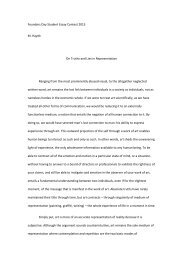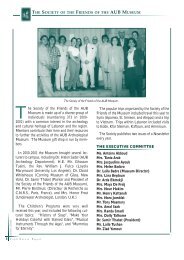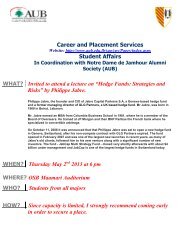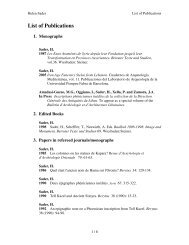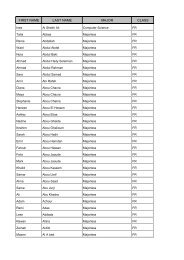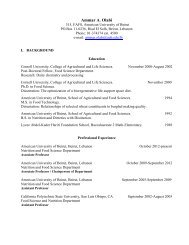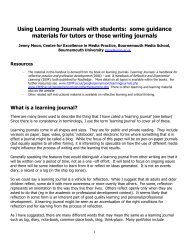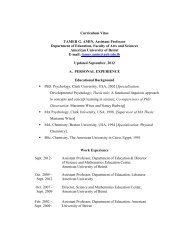The IX t h Makassed Medical Congress - American University of Beirut
The IX t h Makassed Medical Congress - American University of Beirut
The IX t h Makassed Medical Congress - American University of Beirut
Create successful ePaper yourself
Turn your PDF publications into a flip-book with our unique Google optimized e-Paper software.
474 Valvular, Myocardial, Pericardial, and Cardiopulmonary Disease<br />
<strong>The</strong> future<br />
Disclosure<br />
References and Recommended Reading<br />
Papers <strong>of</strong> particular interest, published recently,<br />
have been highlighted as:<br />
• Of importance<br />
•• Of major importance<br />
1. Bonow RO, Carabello BA, Chatterjee K, et al.; <strong>American</strong><br />
College <strong>of</strong> Cardiology/<strong>American</strong> Heart Association Task Force<br />
on Practice Guidelines: 2008 focused update incorporated<br />
into the ACC/AHA 2006 guidelines for the management <strong>of</strong><br />
patients with valvular heart disease: a report <strong>of</strong> the <strong>American</strong><br />
College <strong>of</strong> Cardiology/<strong>American</strong> Heart Association Task Force<br />
on Practice Guidelines (Writing Committee to revise the 1998<br />
guidelines for the management <strong>of</strong> patients with valvular heart<br />
disease). Endorsed by the Society <strong>of</strong> Cardiovascular Anesthesiologists,<br />
Society for Cardiovascular Angiography and<br />
Interventions, and Society <strong>of</strong> Thoracic Surgeons. J Am Coll<br />
Cardiol 2008, 52:e1–e142.<br />
2. Iung B, Baron G, Butchart EG, et al.: A prospective survey<br />
<strong>of</strong> patients with valvular heart disease in Europe: <strong>The</strong> Euro<br />
Heart Survey on Valvular Heart Disease. Eur Heart J 2003,<br />
24:1231–1243.<br />
3. Nkomo VT, Gardin JM, Skelton TN, et al.: Burden <strong>of</strong><br />
valvular heart diseases: a population-based study. Lancet<br />
2006, 368:1005–1011.<br />
can be used for patients in this cohort who do not have adequate transfemoral<br />
access. Enrollment in this arm also was completed recently.<br />
• This study is unique in several ways. All patients were carefully selected<br />
after review by the investigators during twice-weekly conference calls.<br />
During each stage <strong>of</strong> the study, surgeons and cardiologists work very<br />
closely to select patients and to determine the approach, the actual procedure,<br />
and postprocedural care. This study will provide critical information<br />
on treatment options for this expanding patient population.<br />
• <strong>The</strong> rapid application <strong>of</strong> this procedure in Europe and Canada suggests that<br />
it is a very valuable treatment option for a subset <strong>of</strong> symptomatic patients<br />
with AS at high risk for surgery. Objective pro<strong>of</strong> will come from the PART-<br />
NER trial. New questions will arise as fundamental questions are answered.<br />
<strong>The</strong> next step will be to expand this procedure to lower-risk patients while<br />
making it safer with device and procedural modifi cations. <strong>The</strong> new devices<br />
will potentially provide the option to reposition the valve, making the<br />
procedure more dependable and safer. Decreasing the size <strong>of</strong> the delivery<br />
system will be critical for a more widespread application <strong>of</strong> this technique.<br />
Availability <strong>of</strong> multiple valve sizes also will be crucial for improved success.<br />
As more devices become available, it will be important to determine which<br />
device is better for any specifi c patient or anatomy. Further, the training <strong>of</strong><br />
cardiovascular physicians, development <strong>of</strong> appropriate interventional suites<br />
for performing the procedure, and continued refi nements in the devices and<br />
delivery systems will be critical for the overall success <strong>of</strong> this exciting new<br />
era <strong>of</strong> transcatheter treatment for valvular heart disease.<br />
No potential confl icts <strong>of</strong> interest relevant to this article were reported.<br />
89<br />
4. Lindroos M, Kupari M, Heikkila J, Tilvis R: Prevalence <strong>of</strong><br />
aortic valve abnormalities in the elderly: an echocardiographic<br />
study <strong>of</strong> a random population sample. J Am Coll<br />
Cardiol 1993, 21:1220–1225.<br />
5. <strong>American</strong> College <strong>of</strong> Cardiology/<strong>American</strong> Heart Association<br />
Task Force on Practice Guidelines; Society <strong>of</strong><br />
Cardiovascular Anesthesiologists; Society for Cardiovascular<br />
Angiography and Interventions; Society <strong>of</strong> Thoracic<br />
Surgeons, Bonow RO, Carabello BA, Kanu C, et al.: ACC/<br />
AHA 2006 guidelines for the management <strong>of</strong> patients with<br />
valvular heart disease: a report <strong>of</strong> the <strong>American</strong> College<br />
<strong>of</strong> Cardiology/<strong>American</strong> Heart Association Task Force on<br />
Practice Guidelines (writing committee to revise the 1998<br />
Guidelines for the Management <strong>of</strong> Patients With Valvular<br />
Heart Disease): developed in collaboration with the Society<br />
<strong>of</strong> Cardiovascular Anesthesiologists: endorsed by the<br />
Society for Cardiovascular Angiography and Interventions<br />
and the Society <strong>of</strong> Thoracic Surgeons. Circulation 2006,<br />
114:e84–e231.






